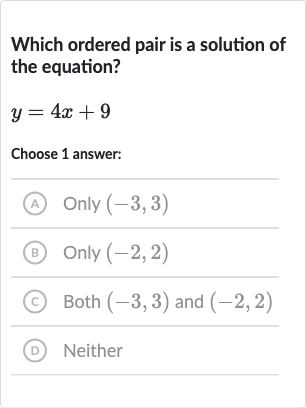Full solution
Q. Which ordered pair is a solution of the equation?Choose answer:(A) Only (B) Only (C) Both and (D) Neither
- Check Solution : Step : Let's determine if the ordered pair satisfies the equation . Substituting into the equation yields . Simplifying, we get , which simplifies to . Since does not equal , the ordered pair is not a solution.
- Check Solution : Step : Now, let's check the second option . For this option, . Substitute into the equation . This gives us . Simplifying this, we get , which simplifies to . Since does not equal , the ordered pair is not a solution of the equation.
- Final Conclusion: Step : Since neither of the ordered pairs nor is a solution of the equation , the correct answer is Neither.

